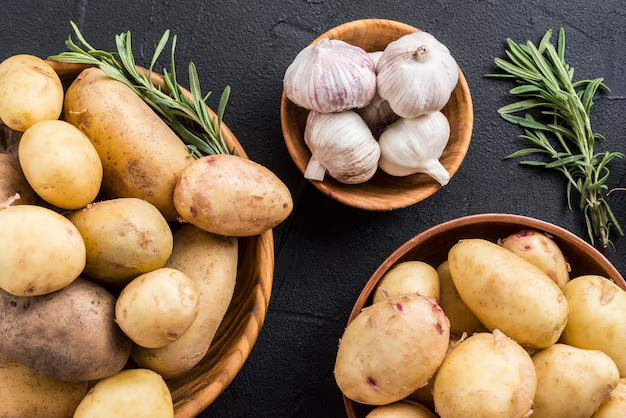How Long Do Potatoes Really Last in the Refrigerator? 🌿
If you've ever found yourself digging through the kitchen's dark corners searching for that forgotten bag of potatoes, you're not alone. Potatoes are a staple in many homes due to their versatility, but their storage can sometimes be puzzling. A common question arises: Do potatoes last longer in the refrigerator? In this detailed guide, we'll explore this topic and provide insight into the best ways to store potatoes to maximize their shelf life.
Why Proper Storage Matters
Potatoes are not just any ordinary vegetable. With their dense carbohydrate content and unique storage needs, they require special attention to maintain their quality and nutritional value. Improper storage can lead to sprouting, shriveling, or even spoiling—none of which are ideal for maintaining a well-stocked pantry. Understanding how to store potatoes properly can reduce food waste and help you enjoy your potato dishes, fresher and tastier.
Potatoes: The Basics
Before diving into storage techniques, it's essential to know what makes potatoes tick. As a root vegetable, potatoes contain a lot of water and starch. This composition makes them prone to changes when exposed to different environmental conditions. Moreover, the natural process of sprouting or turning green is a sign of their efforts to grow, which is harmless in small amounts but should be managed for optimal quality.
The Role of Temperature in Potato Storage
One of the primary factors affecting potato shelf life is temperature. Let's take a closer look at how different temperatures impact their longevity.
Room Temperature
Pros:
- Easy access and convenience.
- Natural, suitable environment for short-term storage.
Cons:
- Attracts pests and encourages sprouting.
- Increased risk of bacteria and mold growth.
At room temperature, potatoes can last about 1-2 weeks. This time frame works well for those who buy potatoes in smaller quantities and use them relatively quickly.
Refrigeration
Pros:
- Slows down sprouting.
- Extends the shelf life, preventing spoilage.
Cons:
- Can convert starch to sugar, affecting taste.
- May cause a change in texture and color.
Refrigerating potatoes can help them last several weeks longer. However, the chill can cause unwanted changes, such as a sweeter taste and darker appearance when cooked, due to the starch-to-sugar conversion. In cold environments, potatoes can last up to 2-3 months under optimal circumstances.
The Best Storage Practices for Potatoes
While refrigeration might seem like a viable option, blending it with other best practices can maximize freshness and quality.
Ventilation is Key
Ventilation prevents moisture buildup, which can lead to rot. Store potatoes in burlap or paper bags instead of plastic to allow for adequate airflow.
Darkness is Essential
Potatoes should be stored in a dark place to prevent greening and sprouting. A pantry or cellar with no sunlight exposure works best.
Separate from Other Produce
Some fruits, like apples, release ethylene gas which can promote sprouting in potatoes. Store potatoes away from other fruits and vegetables to avoid this.
Check Regularly
Every week or so, check your potato inventory for signs of rot or sprouting. Catching these problems early can prevent them from spreading to other potatoes.
Consider the Variety of Potato
The type of potato you choose can also affect storage outcomes. Different varieties may have different optimal storage conditions.
Russets
Known for their fluffy texture when cooked, Russets store quite well in cool, dry environments. Refrigeration might change their texture, but they hold up well for extended periods when kept dry and dark.
Red Potatoes
Red potatoes are more suitable for shorter storage durations. They're denser, with more moisture, and are best used promptly to avoid becoming mushy.
Yukon Gold
These have a waxy texture and can withstand refrigeration better than some others. However, they are best consumed within a couple of weeks for optimal flavor and texture.
Addressing Sprouting and Greening
Sometimes, despite your best efforts, potatoes start sprouting or turning green. Here's how to handle these situations:
Dealing with Sprouts
If small sprouts appear, they can be easily removed before cooking. Large sprouts, however, might indicate the potato has aged too much and might not be ideal for consumption.
Handling Greening
Green spots, due to chlorophyll, can indicate the presence of solanine, a natural toxin. While small amounts aren't dangerous when removed, it's crucial to cut away green areas before use.
In Summary: Optimal Potato Storage Tips 📝
Here's a handy list to help you keep your potatoes fresh and ready:
- 🌡️Temperature: Store at room temperature, with refrigeration only if planning long-term storage.
- 🕶️Darkness: Keep them in a dark place, like a pantry or cellar.
- 🍃Ventilation: Use breathable bags and allow for airflow.
- 📏Check Regularly: Monitor for rot, sprouts, and remove them promptly.
- 🥔Variety Matters: Choose appropriate storage methods based on potato type.
What About Cooked Potatoes?
While our focus has been on raw potatoes, cooked potatoes also need proper storage to maintain safety and quality.
Storing Cooked Potatoes
Once cooled, place cooked potatoes in an airtight container before storing them in the refrigerator. They typically last 3-5 days. For longer storage, consider freezing them, although the texture might change slightly upon thawing.
Freezing Tips
Blanch potatoes before freezing to help maintain their texture. Use them in dishes like soups and casseroles where texture is less noticeable.
Closing Thoughts
While refrigeration can extend a potato's life, it's not always the best choice for flavor and texture. Instead, aim for a balanced approach using cool, dark, and well-ventilated conditions. By considering the type of potato and closely monitoring their condition, you can enjoy fresh, delicious potatoes in your meals for weeks or even months to come. Remember, the key is to learn and adapt storage habits that best fit your cooking style and kitchen setup.
